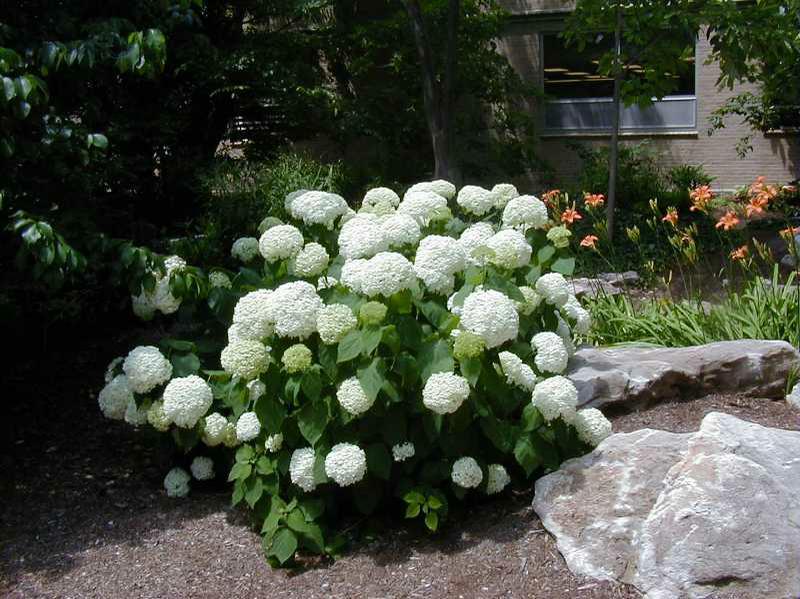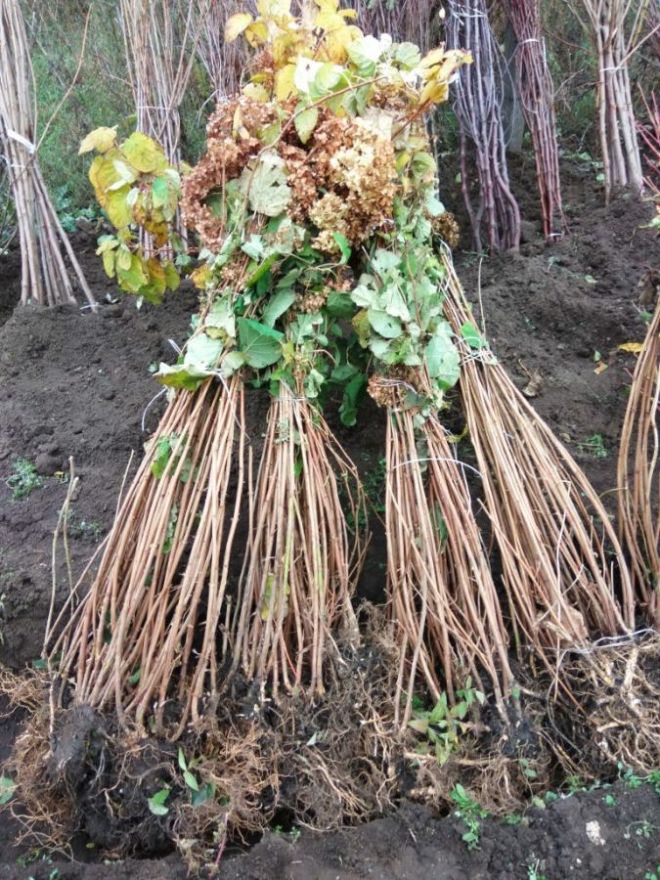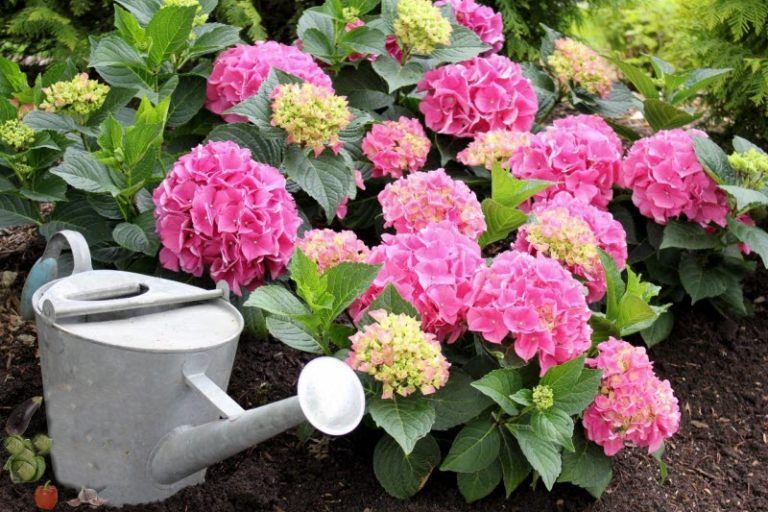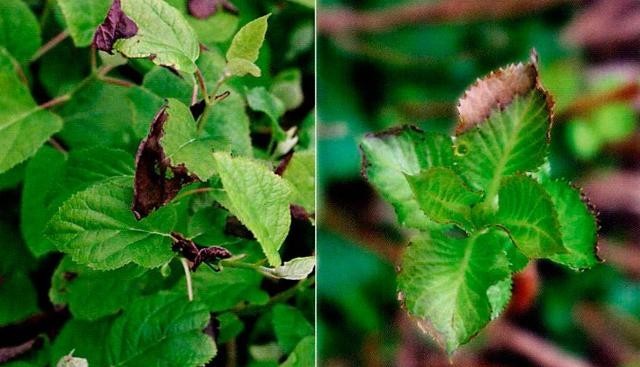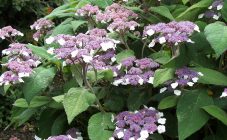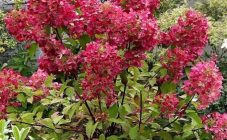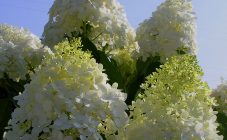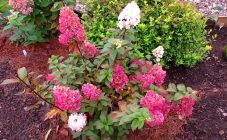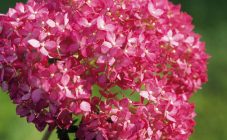Content:
Hydrangea is one of the most beautiful plants in the garden. It can grow alone or in combination with other plantings. These shrubs come in many varieties. Gardeners have long appreciated the hydrangea for its unpretentious care, beauty during flowering.
Characteristic
On various continents, there are about 35 species of deciduous shrubs belonging to the genus of flowering plants of the hydrangea family. Hydrangea, or hydrangia (hudrangea) is translated from Latin as "a vessel with water." During the growing season, the shrub evaporates a lot of water and, if it is not enough, quickly withers.
In gardens, several types of hydrangea are usually displayed: paniculate, tree-like, large-leaved. Plants attract attention with large inflorescences in the form of a ball or panicle, green large leaves. Flowers in a bud are of 2 types: in the middle - small, fruiting, along the edges - large, sterile. The fruit of the hydrangea is a box with many small seeds.
Annabelle tree hydrangea is a beautiful shrub with a height of 1 to 2 meters. She has not very thick pubescent shoots. The leaves, attached to the branches with long petioles, are arranged oppositely. In mid-July, large inflorescences appear on the shoots.
The bush is up to 1.5 m high, the crown is up to 3 m wide. Its leaves are rich green, oval, with a pointed end, which retain their bright color until frost. Hydrangea Anabel blooms in late June with white buds and stays like this until September. The inflorescence is dense, consisting of many small white flowers. Its length reaches 20-25 cm. This variety is not capricious, resistant to unfavorable climatic conditions, it can grow even in Siberia. In one place, the bush can grow up to 50 years without losing its decorative appearance.
Hydrangea Strong Annabel is one of the varieties of Annabel. The height is the same, but the flowering is much more abundant: under the balls at this time, you can hardly see the foliage. The variety tolerates frost well, is resistant to diseases.
Hydrangea Pink Annabelle has pink flower caps. Initially dark pink, over time the color changes to a lighter one. The shoots of the bush are powerful, strong, do not bend to the ground even during the period of abundant flowering. The compact shape of the bush remains throughout the season.
Landing
Planting and caring for Anabelle hydrangea is easy. The plant prefers to grow on fertile, loose, well-moistened soils. It is planted in partial shade or in sunny areas. These places must be protected from northerly winds. The root system of the hydrangea is pre-soaked for a short time in a weak solution of potassium permanganate.
If several plants are planted, for example, Annabelle and Strong Annabelle hydrangea, the distance between them should be 1.5-2 m. The planting hole is dug up to 50 cm deep. Humus and complex fertilizer are added to it. Plants are planted in the prepared hole so that the root collar is not buried.
After planting, the earth is watered and compacted. The trunk circle is mulched with leaf humus, peat, sawdust. When growing a plant in regions with a more severe climate, for example, in the Urals, after planting, a canopy is made of shields.
Reproduction
Perhaps in 4 ways: by seeds, cuttings, dividing the bush, layering. Let's consider each of them.
Seeds
Hydrangea seeds are small, so it is better to germinate them first. They are previously soaked in a growth stimulant solution. Then cotton wool is laid out on a saucer, seeds are laid out on it, which are covered with another layer of cotton wool. A little boiled water is poured into a saucer so that the cotton wool is moistened, but does not float in the liquid.
After the seeds hatch, they are planted in a prepared soil mixture, consisting of peat, humus, sand, leafy earth, and are slightly covered with it. The seedling containers should be shallow, drainage pours out to the bottom. The grown seedlings are planted in the prepared place of the garden plot.
Also, seeds can be sown directly on the site in spring or autumn. In this case, they do not germinate, they are sown over the soil. It is not necessary to deepen: in the spring they are watered for contact with the ground, and in the fall they will gradually deepen themselves.
By cuttings
This is one of the best methods for vegetative propagation. This method can be used to breed all types of hydrangia, including one of the most beautiful - the tree hydrangea Pink Anabel. Rooting is done with green cuttings under a film cover. Here's how it's done:
- cuttings are cut;
- the place of the lower cut is processed with a growth stimulant;
- a substrate is prepared from sand and peat;
- cuttings are planted to a depth of 3 cm with an interval of 5 cm in a row and 5 cm between rows;
- every day the greenhouse is ventilated, the seedlings are sprayed with water.
If the greenhouse is located in an open area, it must be shaded so that moisture does not evaporate from the leaves. This is done with burlap, shields, or other materials.
Propagation by cuttings can also be done indoors. To do this, cut cuttings are planted in pots with a substrate of peat and sand. Top covered with a plastic bottle with a cut off bottom or film. Airing and moisturizing the plant is required. When the cutting takes root, it is planted in the garden in the spring.
By dividing the bush
This method is used in spring or early fall. This happens in the following sequence:
- the bush is undermined with a pitchfork;
- the plant is divided into parts: each division must have roots and shoots;
- each bush is planted in a prepared planting pit;
- the plants are watered, the planting circle is mulched with peat or sawdust.
Layers
Rooting by layers is done in spring or autumn. The procedure is not laborious, and by the spring several young shoots with roots are formed, ready for transplantation. The rooting process by layering step by step:
- the soil around the bush is dug up and leveled;
- the branch chosen for rooting is laid horizontally to the ground and slightly pressed into it;
- in several places the shoot is pinned or pressed to the ground with pebbles;
- a small part of the top should remain above the soil surface;
- a little earth is poured on top of the shoots, which is then slightly moistened.
After 3 weeks, roots and young shoots will appear on the shoot. When they reach a length of 10 cm, hilling is necessary. Cuttings are separated and planted in a year, in spring or autumn.
Care
To properly care for a hydrangea, it must be watered abundantly, loosened, fed, cut off. Hydrangea will build up a lush green mass and bloom with beautiful lush buds.
Watering
Hydrangea bushes are moisture-loving, so you need to water it often, at least 1 time a week. At least 2 buckets of water are poured under each bush. In dry summers, watering increases up to 2 times in 7 days. The water should be warm, heated in the sun. Periodically, you can add a little potassium permanganate to it to prevent rot. Watering is done in the morning or evening.
Loosening and mulching
The soil should be loose, free from weeds. When loosening, moisture will be retained, there will be air access to the roots. In hydrangea, the root system is located close to the soil surface, so loosening is done no deeper than 3-7 cm.
To protect the soil from overheating, preserve moisture, the soil is mulched. Peat, sawdust or a mixture of these materials are selected as mulch. Layer thickness - 3-5 cm.
Pruning
There are sanitary pruning and shaping. When sanitary, all broken, old, diseased shoots are cut out. Trimming in this case is done to the very base.
Formative pruning is done in the spring, before sap flow. This rule is common to all chrysanthemums, including the Pink Annabelle hydrangea. The procedure promotes better tillering. Cuttings can be used for propagation. If you leave one shoot and cut the rest, the hydrangea will form into a tree.
Potential diseases and pests
Although hydrangea is a fairly disease-resistant plant, some of them are sometimes affected.
- Mealy dew... It is caused by soil-borne fungi. All affected parts are removed, the bush is treated with a solution of any fungicide.
- Gray rot... Fungal disease primarily affecting young cuttings. The treatment is similar: the affected shoots are cut out, the remaining ones are sprayed with a fungicide solution.
- Annular spotting... Refers to viral diseases. Possible causes of the disease are infected planting material, the use of poorly processed tools, and various insects can also infect. The disease cannot be treated: the bush is destroyed.
- Chlorosis... The disease is characterized by yellowing of the leaves. In this case, the lack of iron affects. As a treatment, feeding with iron preparations is performed.
Hydrangea can also be attacked by various insects and pests. Timely detection of them and the measures taken to combat them will save the bushes from death.
- Leaf aphid. It is very dangerous, since it can drink juice from leaves and stems in a short time. Ladybugs can handle it. If there are too many aphids, the plant is sprayed with insecticidal preparations.
- Spider mite. He easily discovers himself by the fact that in his habitat the branches will be braided with cobwebs. Control measures are the same: spraying with insecticides.
- Slugs. Plant in humid places, eat up foliage and stems. They are harvested by hand or a molluscicide that is scattered around the slugs' habitats.
Using hydrangea in garden design
Hydrangea in the garden is planted both singly and in an ensemble with other plants. In landscape design, the use of hydrangea is very diverse. It is very popular with garden architects of the Moscow region.
One of the options is that it can be planted in the coastal area, where it will become the main decorative element. Hosts, incense, astilba, and other moisture-loving flowers will look good nearby. Even when the hydrangea fades, the composition will look beautiful due to the variety of leaf plates.
Hydrangea can grow in one place for many years. Given this fact, the gardener can change the appearance of his site annually, planting other plants to it each time. And vice versa, having planted beautiful perennial shrubs next to the hydrangea, the gardener will keep his garden in a consistently decorative, unchanging state.
